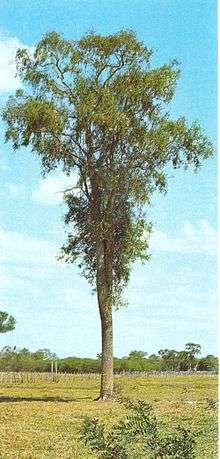Aspidosperma quebracho-blanco
| Quebracho blanco | |
|---|---|
 | |
| Scientific classification | |
| Kingdom: | Plantae |
| (unranked): | Angiosperms |
| (unranked): | Eudicots |
| (unranked): | Asterids |
| Order: | Gentianales |
| Family: | Apocynaceae |
| Genus: | Aspidosperma |
| Species: | A. quebracho-blanco |
| Binomial name | |
| Aspidosperma quebracho-blanco Schltr. | |
| Synonyms[1] | |
| |
Quebracho blanco, called kebrako or white quebracho,[2] is a South American tree species, native to Brazil, N Argentina, Bolivia, Paraguay, and Uruguay.[1] It must not be confused with other species also known as quebracho, but belonging to the genus Schinopsis.[3]
Growth

Quebracho blanco wood is uniformly yellow-ochre, without differences between hardwood and sapwood. It is quite heavy (relative density = 0.885 g/cm³) and hard, and responds well to bending and shock. Upon drying it tends to collapse, producing deformations and cracks, so the drying process is slow; the wood must be treated with fungicides. It is easy to work and has many uses in carpentry (carts, wheels, floors, shoes, tool handles, furniture); it is also good for chess pieces, skis, etc. Preserved with creosote it can be used outdoors. In some places it is widely used as coal, since it does not produce sparks or large amounts of ash, and it burns strong and slowly.[4]
Other chemicals
Quebrachitol is a cyclitol, a cyclic polyol found in the bark of A. quebracho.[5]
Cultivars
References
- 1 2 Kew World Checklist of Selected Plant Families
- ↑ "USDA GRIN Taxonomy".
- ↑ Morales, J.F. (2010). La familia Apocynaceae s. str. (Apocynoideae, Rauvofioideae) en Uruguay. Darwiniana 48: 68-86.
- ↑ Libro del Árbol, Tome II, edited by Celulosa Argentina S. A., Buenos Aires, Argentina, October 1975.
- ↑ Quebrachitol. Jan van Alphen, Ind. Eng. Chem., 1951, 43 (1), pp 141–145, doi:10.1021/ie50493a041
- ↑ Govaerts, R., Michielsen, K. & Jablonski, E. (2011). Untraced Weeping Broadleaf cultivars: an overview. Belgische Dendrologie Belge Archived March 22, 2012, at the Wayback Machine. 2009: 19-30.